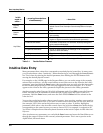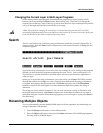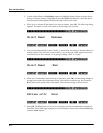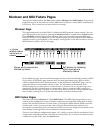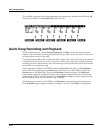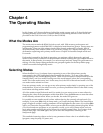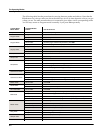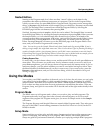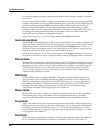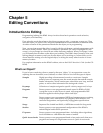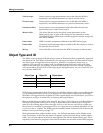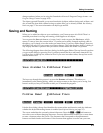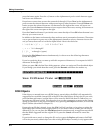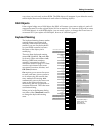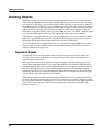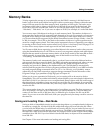
4-4
The Operating Modes
Using the Modes
or controlling additional synths connected to the K2661’s MIDI Out port. Chapter 7 describes
Setup mode .
If you’re using a different MIDI controller, you can make use of Setup mode even if your MIDI
controller can transmit on only one MIDI channel at a time. To do this, go to the RECEIVE page
in MIDI mode (by pressing the RECV soft button while in MIDI mode), and set the Local
Keyboard Channel parameter to a value that matches the transmit channel of your MIDI
controller. When you select Setup mode, the K2661 will interpret incoming MIDI information
according to the settings for the currently selected setup. See the discussion of the Local
Keyboard Channel parameter in Chapter 10 for details.
Setup mode also gives you access to Sample mode via the Sample soft button.
Quick Access Mode
Another feature for live performance, Quick Access mode enables you to combine programs and
setups into banks of ten entries. Each of these programs or setups can be selected with a single
alphanumeric button. Different banks are selected with the Chan/Bank buttons. There’s a
selection of factory preset banks, and you can use the Quick Access Editor to create your own
banks and store them in RAM. There’s a full description in Chapter 8.
Quick Access mode gives you access to Sample mode via the Sample soft button. You can also
use Quick Access banks as a way to remap incoming or outgoing Program Change commands.
Effects Mode
Effects mode sets the behavior of the KDFX effects processor. The Effects-mode page lets you tell
the K2661 how to select preset studios (programmed effects configurations) when you change
programs or setups, or lets you choose a preset studio that’s applied to every K2661 program.
The Studio Editor allows you to tweak the preset studios, and create your own. Chapters 9
shows you how. You can also listen to the sounds of various effects while in Effects mode,
without selecting different programs.
MIDI Mode
You’ll use MIDI mode to configure the K2661’s interaction with other MIDI instruments, by
setting parameters for transmitting and receiving MIDI. You’ll also use it to configure your
K2661 for multi-timbral sequencing. On the CHANNELS page, you can assign a program to
each channel, and enable or disable each channel’s response to three types of MIDI control
messages: Program Change, volume and pan. You can also override program output
assignments, and adjust overall program gain. See Chapter 10.
Master Mode
Master mode, described in Chapter 11, contains the parameters that control the entire K2661.
Global settings for tuning, transposition, velocity and aftertouch sensitivity, and other
preferences are adjusted here. You can also get to GM Mode and SampleMode from here.
Song Mode
Song mode enables you to play sequences (songs) stored in the K2661’s RAM, and provides a
fully featured sequencer that you can use to record songs. You can also record multi-timbrally
via MIDI, or load standard MIDI files (Type 0 or 1). The Song Editor enables you to modify
existing RAM sequences, do step recording, and create arrangements (by linking two or more
songs together). See Chapter 12.
Disk Mode
Disk mode lets you load and save programs and other objects using the K2661’s SmartMedia
drive or a disk (or CD-ROM drive) connected to the K2661’s SCSI port. See Chapter 13.



